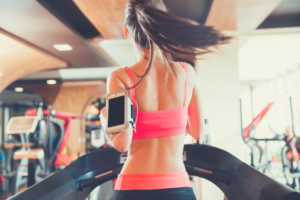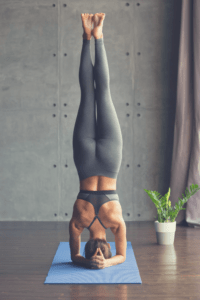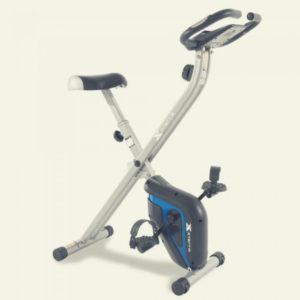Rowing machines have been fixtures in gyms everywhere for quite some time. Specialty gyms like Orangetheory and even Olympic athletes have contributed to the machine’s popularity.
It isn’t until recently, however, that you’ve started to see lines of gym-goers waiting for their turn on the machine.
More and more people are investing in rowers, but with all the various types, finding the best rower for your needs can seem like looking for a needle in a pile of needles.
We’re going to take a look at two of the most popular rowers – the air rower and the magnetic rower.
Before we get to the machines, let’s examine why a rower is one of the best pieces of home gym equipment you can invest in.
Air Rower vs. Magnetic Rower: Is One Better Than The Other?
Benefits of Rowing
It Works the Whole Body
A rower offers a full-body workout that works 86% of your muscles, an impressive rower considering that most think of a rower as focused on the upper body.
When using the correct form – more on that in a bit – you’ll use your legs for 65-75% of the work, while your upper body handles the other 25-35%.
As you push back with your legs, you engage your glutes, calves, and quads.
When you get to the point where your legs are almost straight, you engage your core, chest, arms, and back as you pull the arm handle.
The focus on your postural muscles is especially beneficial for people who find themselves looking down at a computer for most of their day.
The best part of working your whole body? When you engage multiple muscle groups, you amp up your calorie burn.
Anyone Can Do It
Rowers are a fantastic workout for people of any fitness level. The only thing to keep an eye on is the machine’s weight capacity.
Aside from that, its ability to increase or decrease the resistance level and the simple movements make it a less intimidating machine for older adults and those who are new to fitness.
According to a study by the National Institute of Health it’s even safe for people who are visually impaired and helped to decrease the percentage of body fat and reduced LDL cholesterol levels.
It’s Safe for Your Joints
One of the reasons why a rower is so well-suited for all fitness levels is the fact that it’s low impact.
Low impact is often confused with low intensity, but you can absolutely get a high-intensity workout on a low-impact machine like a rower.
Intensity is measured by your heart and respiratory rate, while the impact is based on the stress placed on your body, primarily the impact on your joints.
When you run and jump, your body is pulled down by gravity, and the impact on your joints can be problematic for seniors, those recovering from injury, or who suffer from obesity.
However, when you use a rower, you remove that jarring impact typical of running on a treadmill, box, and squat jumps and many of the high-intensity interval training workouts you see because you’re seated.
It Can Relieve Stress
As with all forms of exercise, when you row, there’s a release of endorphins that can help to boost your mood.
Studies upon studies have found that working out consistently can help relieve stress, and it’s strongly recommended for people who suffer from depression, bipolar disorder, and other mental health issues.
Rowing has the added bonus of a repetitive, fluid motion that many find to be meditative.
By removing the need to concentrate and follow along, perhaps like you would in a cardio dance class, you allow your mind to relax.
It Can Improve Your Heart and Lung Health
Cardio workouts like rowing improve your cardiovascular health.
As your whole body works at a higher intensity, your heart and blood vessels strengthen, making carrying nutrients and oxygen much easier on your body.
For people at risk of heart issues, smokers, and those with respiratory problems, a rower is an excellent alternative to the more common cardio workouts.
It’s a Great Alternative to Traditional Home Exercise Equipment
When people think cardio equipment, the three most popular machines are likely the treadmill, cycling bikes, and ellipticals.
These are all great options to increase your health. However, the best piece of equipment for you will vary significantly based on your specific needs.
Treadmills are a fantastic option for runners and walkers, and the ability to set a particular pace allows you to maintain your intensity.
The same goes for upright bikes, also known as cycling bikes; you can select your speed and resistance.
However, treadmills and cycling bikes don’t provide a lot of upper bodywork, so it may not be a great choice if you’re looking to max your calorie burn with a full-body workout.
Ellipticals are another fantastic choice that offers an upper-body workout with the use of handlebars and is considered low impact.
If you’re purchasing an elliptical, however, keep in mind that it’s particularly bulky, and unlike many rowers, it’s not collapsible, so you may require additional space.
How to Use a Rower Properly
While rowing movements are relatively simple, it’s still important to use the correct form to get the most benefits from your workout and prevent injury.
One of the keys to maintaining proper form is to keep your legs straight and make sure that you’re not blowing them out to your sides.
You don’t want to lock your knees when you pull back, so keep your knees nice and soft throughout the motion.
Keeping your shoulders back, your core tight, and your head neutral can prevent back problems.
There are a few common mistakes that people make when using a rower. Many people use scooping when they pull the arm handle, known as the oar, back and forth.
It’s essential to pull the oar straight back towards your chest, not your neck, and that the path back towards the flywheel is just as straight.
It’s also pretty common to see people gripping the oar so hard that their knuckles start to whiten. It’s best to keep a light grip.
Last but not least, make sure that your feet are strapped in right above the joint of your big toe.

Types of Rowers
Now that you know the benefits and how to use a rower, let’s take a deeper dive into the air rower and magnetic rower.
Air Rowers
This type of rower most similarly mimics the feeling of being on the water. It offers a smooth stroke and utilizes air to provide resistance.
It works by utilizing a fan flywheel. As you pull the handle, the flywheel rotates, creating wind. The wind makes it harder to pull the handle.
Most of the newer models of air rowers additionally have a damper feature. The damper controls how much air is able to flow into the flywheel.
This controlled airflow will essentially determine the amount of drag. The damper feature helps to regulate how heavy or light the motion feels.
The lower the damper setting, the lighter the row will feel.
The critical thing to note about the resistance of air rowers is that there are no resistance controls.
You adjust your resistance by rowing faster. For example, doubling your speed can increase your resistance by eight times.
The monitors available on air rowers vary widely based on the model and brand of the rower.
However, one benefit across all air rowers is the accuracy of your activity metrics like distance, speed, time, and power.
This is why air rowers tend to be the rower of choice for athletes.
If you’re intrigued by the proposition of an air rower, check out our review on the best air rowers for small home gyms.
Highly Recommended Air Rowers
| Murtisol Air Resistance Rowing Machine | XTERRA Fitness ERG700 Air Rower | Stamina ATS Air Rower |
 |
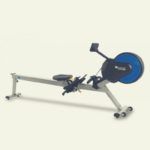 |
 |
| One of the things we like the most from the Murtisol Air Resistance Rowing Machine is the rotatable display screen that allows you to find the most comfortable view while working out. | The XTERRA Fitness ERG700 Air Rower is a cut above the rest in our book with 16 levels of resistance and the option to switch back between air resistance and magnetic resistance. | The Stamina ATS Air Rower made our list because we like the free access to müüv, the smart audio coaching app that allows you to really take advantage of your cardio machine. |
 |
 |
 |
Magnetic Rowers
Magnetic rowers utilize a different method of increasing the resistance. These types of rowers use, you guessed it, magnetics positioned so that resistance can be modified based on the relation of one magnet to another.
When the magnets are closer to each other, the resistance is increased and vice versa. This approach to resistance allows you to have a set resistance regardless of how fast you row.
A good comparison is an incline on a treadmill; you can keep your incline set and still vary your speed.
As the magnets cause no friction, magnetic rowers are almost entirely silent, making it the preferred choice for people who live in apartments or condos where neighbors may be irritated by a louder machine.
Again, there’s a wide range of features available on a magnetic rowers monitor.
These types of machines aren’t able to calculate metrics as accurately as other rowers, but that likely isn’t a huge factor unless you’re competing.
Magnetic rowers typically have built-in workouts available that include spikes in resistance or speed, which helps take some of the guesswork out of your training.
It also ensures that you don’t pull back on the intensity of your workout.
Highly Recommended Magnetic Rowers
| Sunny Health & Fitness Magnetic Rowing Machine | XTERRA FITNESS ERG160 Magnetic Rower | Bluefin Fitness BLADE Home Gym Foldable Rowing Machine |
 |
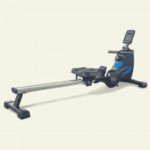 |
 |
| Sunny Health & Fitness Magnetic Rowing Machine stands out because of it’s extra long slide rail that allows you to adjust to whatever high your at for maximum comfort. | XTERRA FITNESS ERG160 Magnetic Rower stands out because of its padded handle, large molded seat, and adjustable foot straps that all make for a comfortable ride. | Bluefin Fitness BLADE Home Gym Foldable Rowing Machine comes with Bluetooth capability and a smart phone app, making it a perfect companion for more tech-oriented users. |
 |
 |
 |
Air Rowers vs. Magnetic Rowers: So Which is Better?
The differences between an air rower and a magnetic rower are subtle but can make a huge impact on how often and when you use the machine.
So, let’s take a look at the two options head to head.
Similarities
Both types of rowers are known for their smooth stroke and utilize a flywheel mechanism.
Their price ranges are both very in line with each other, and they offer the same health benefits.
The technique used to row is also the same. Most models of rowers are also collapsible, which makes them an excellent alternative to bulky treadmills, ellipticals, and cycling bikes.
Differences
Resistance
The air rower uses variable resistance that’s based on airflow to the flywheel.
This means that resistance can only be increased by the speed of your row, unlike the magnetic rower that allows you to control resistance regardless of your speed.
The air rower may be a better option for resistance if you intend to primarily use the rower for cardio purposes.
A magnetic rower is a good option if you’d like to rotate between mainly strength or mostly cardio rowing workouts.
Noise Level
As an air rower uses wind to create drag and resistance, they are known to be pretty noisy, whereas the magnetic rower’s mechanism allows for a quieter ride.
If your home gym is located in an area where noise isn’t an issue, say in a garage or in the basement of a single-family home, the noise may not be an issue.
On the other hand, a magnetic rower is virtually silent, making it an excellent option regardless of your living situation.
Monitor and Metrics
The resistance, speed, and distance are more accurately tracked on the air rower versus the magnetic rower, so air rowers will likely be a better option for those looking to compete against other rowers.
A magnetic rower, while less accurate, offers the ability to use built-in workouts to maximize your efforts, which is especially helpful for those who are new rowing, or to fitness in general.

Final Thoughts
When it comes down to effectiveness, both air and magnetic rowers are comparable, so it’s crucial to select the rower you think you will use more often.
For example, if you’re an early riser and like to get your workout in at 5 am, but you have a family or neighbors you don’t want to wake, the magnetic rower may make it more convenient.
If friendly competition and tracking your stats is your idea of motivation, then go with the air rower.
The key to any exercise is to select something that makes it fun and easy to get those workout minutes in.

